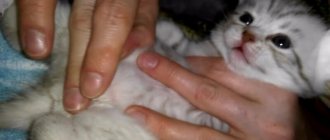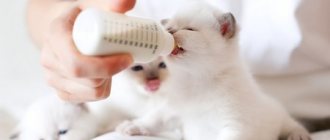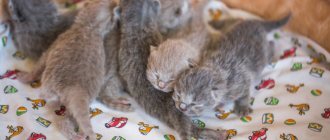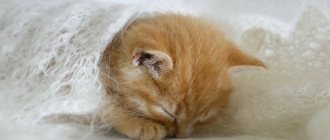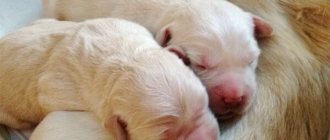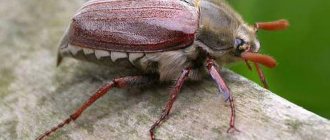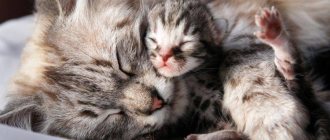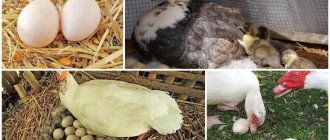When everyone's favorite grows up and becomes a mother, then, as a rule, the worries placed on the owner's shoulders increase. Cats and kittens need a cozy corner, hidden from prying eyes. When kittens are completely newborn, they do not need the care of the owner. The responsibility and burden falls on him during the period when they begin to walk. In our article we will answer such questions as: at what age do small kittens begin to walk and crawl, we will talk about the features of the locomotor system, and the intricacies of caring for a kitten during this period.
Details of the development of a cat's paws and body
The cat's skeleton as a whole deserves attention. It consists of 250 bones, and is very strong and flexible. By the way, did you know why a cat will crawl anywhere its skull can fit? It's all about her collarbones, which are represented by two bones that are not attached to the shoulder joint, and also about the fact that the shoulder blades are connected to the spine only by ligaments, muscles and tendons.
cat skeletal structure
Fundamentals of limb structure
The cat's front paws have incredible elasticity, which allows them to jump easily and safely and land comfortably. They do not have a solid connection with the skeleton, but are connected to it through elastic and strong tendons. You've probably spread your cat's front paws in different directions and felt how easy it is to do this. This anatomical feature is called a floating shoulder.
The hind legs are designed for propulsion when jumping. They are rigidly attached to the pelvis, have a greater length and thickness, and in general are much better developed than the anterior ones. Thanks to this structure, cats can move very quickly in any direction. They are excellent tree climbers and runners. One more question to ask: why do cats walk silently? This is another feature of the musculoskeletal system: they are digitigrade animals, that is, they walk on tiptoes. This ensures their silent and smooth gait, and gives them an advantage in speed: when running, the cat does not fall on loose surfaces such as sand.
Fact! Cats also have polydactyly and oligodactyly - more or less fingers. This is inherited and does not interfere with the pet’s life in any way.
Functions of cat paws
- Sociable
Cats communicate with their paws not only during a fight, but also by leaving secretions from the glands, and also due to their sensitivity.
- Nutrition assistance
If the bowl gets in the way of the whiskers, the cat helps himself with his paws
- Movement
Felines deftly cling to almost any surface, quickly moving towards the object of their interest, even when it is quite high up.
Kittens love to climb trees
- Depreciation
Allows you to land smoothly and safely when jumping
- Defenses and attacks
A special set of muscles allows cats to keep their claws to themselves in a relaxed state, and by stretching the muscles to release them for attack or defense.
- Care
With the help of their paws and tongue, cats can wash themselves completely, reaching all parts of the body. This allows them to be clean and well-groomed, while imparting their special scent to their fur.
Cats are very clean from an early age
Also, cats relax with the help of their paws when they move their pads over surfaces, feel objects, and much more.
Features of nutrition of a newborn kitten
For the first few weeks after birth, the baby feeds on the mother cat's milk. It contains all the nutritional elements necessary for a fragile body:
- microelements;
- antibodies that form colostral immunity, which contributes to the body’s immunity to various pathogens during breastfeeding.
The newborn baby is still weak and needs care
In the first days, the baby eats colostrum, which affects the immune system. Then it is replaced by milk. It contains antibodies that produce local immunity.
For your information! Cat milk promotes normal growth of the kitten. This feeding is the best option for a newborn pet.
Breastfeeding by a mother cat is carried out for 40-60 days from the moment the babies are born. Based on the size of the kittens, they can be breastfed for up to 6 months. But only for the first 1.5-2 months the cat provides basic nutrition.
Mom is able to feed several kittens at once
Then you need to introduce meat jars, starting with chicken, beef. From the 5th week, finely chopped chicken fillet is offered. First, the whole piece is placed in the freezer, then thawed at room temperature and covered with a little calcide. It can be found in any pharmacy, it consists of eggshells.
The kitten is also offered special professional food for babies from 1 month. has proven itself well in this regard. It produces a light mousse designed for kittens.
Drinking regime
The daily dose in drinking is calculated as follows: the weight of the animal is multiplied by 0.03. The indicator will show the required amount of liquid that the pet should drink per day. The value also includes the water present in the wet food. Usually it takes 80%.
It is best to give your baby clean, filtered water. If it is hard, smells of bleach, and rotten, then he will refuse it.
Note! Cats like the bowl to be full and wide, and their whiskers should not touch the container. Some cats love to drink from a fountain.
Some cats love to drink from a fountain.
Development of the motor system - stages
- 0-6 days . The kids are still blind and deaf. They weigh about 100g and have no thermoregulation. They crawl on their bellies, using their front legs, which are still very weak. The little ones can’t stand yet and don’t even try, the main thing is to find their mother. In the first days of life, the sense of smell is enough for 60-70 cm, but usually cats themselves will not go far or for a long time.
The kittens in the photo are about 7 days old
- 6-12 days . The front paws are constantly trained by moving through the cat's belly. Sensory skills are actively developing. Kittens can smell scents from a distance.
- 12-14 days . As soon as the eyes open, the kitten becomes more confident, even though it still doesn’t see well. He tries to get up on his paws and moves more actively. The hind limbs, muscles and joints begin to develop. Seeing his mother and brothers for the first time, the baby learns to communicate and everything he needs in the future through trial and error.
- 14-20 days . Already grown-up children diligently develop their musculoskeletal system, their joints become stronger. The kittens are trying to walk and even run on their own, but they still stagger and stumble. During this period, it is worth starting to pick up the kittens and, gradually increasing the time, pet them more often and longer. This way they will grow up tame and affectionate.
This is what kittens look like closer to 3 weeks of life
- 20+ days . The cats don't sit still for a minute anymore. They can run and jump, and using new skills gives them great pleasure. They are teething and weigh up to 400 grams.
A little more about development. The umbilical cord most often falls off in the first 4 days. Up to 10 days is considered normal if the kitten only sleeps, waking up to drink cat milk once every 2 hours.
Three-week-old kittens, in general, already know how to walk, scratch behind the ears and much more, but some babies may be delayed in development. This is due to their condition at birth, the number and sequence of births, and the quality of nutrition of nursing mothers. It is very important to feed the cat well and fully, because until the babies can come to the bowl and eat the food lying there, mother's milk will be the only food.
By the way, at first, kittens, like all mammals, will have blue eyes with a hint of gray or green. It's simple - the pigment melanin, which gives the iris its color, accumulates in the first months of life.
Video “A kitten’s first steps”
In the video we invite you to see how kittens behave when they just start walking.
Was this article helpful?
Thank you for your opinion!
The article was useful. Please share the information with your friends.
Yes (50.00%)
No (50.00%)
X
Please write what is wrong and leave recommendations on the article
Cancel reply
Rate the benefit of the article: Rate the author ( 6 votes, average: 4.67 out of 5)
Discuss the article:
When does a baby first stand on its paws?
The kitten tries its paws at the age of 2 weeks
. In general, the development of kittens of all breeds occurs the same. However, some experienced breeders find a difference and say that this happens differently in different breeds. Girls are usually 1-2 days ahead of boys in development, and short-haired breeds develop slightly faster than long-haired ones. In total, the kitten will try to stand on its paws when it is 10-14 days old, and will fully stand and run in about 20 days.
If the development of a kitten is noticeably delayed compared to the rest of its litter or differs from the general framework, you need to contact a veterinarian. The development of the kitten in the first month determines its entire future life. A specialist will help correct nutrition or other causes of developmental delay.
The nuances of caring for a kitten
The kitten is the same child. If the apartment creates safe conditions for him to run around and play pranks, development will proceed without problems. However, you should still carefully monitor how the kitten moves. Is he limping? Is he lagging behind in development? Full mobility and grace are extremely important for felines.
As soon as the kitten begins to show curiosity about its surroundings, you need to remove everything dangerous from its path. A baby can get into trouble anywhere: get stuck between pieces of furniture, pull a tablecloth and drop a dish, catch its claws on the carpet and dislocate a paw.
If any limb fails the cat when running around or causes pain in the pet, which will be noticeable in the baby’s behavior, you need to visit a veterinarian and find out what’s wrong. The kitten is very fragile, and sometimes the owner himself, and especially young children, can harm the baby. Any rough or sudden movement can break a weak bone in the paw and cause suffering for the baby. You should handle your pet very carefully.
Further development
In the second and third months of life, the kitten's development continues. His eye color becomes permanent. The kittens have learned to find a bowl and litter box, love to interact with people, and are generally ready to go.
At two months, nutrition switches to special food or so-called “natural food”; kittens drink mother’s milk only to feel a pleasant taste and warmth. It is worth feeding them 5 times a day and monitoring how much they eat. There must be water constantly. During this same period of life, one of the most amazing feline skills manifests itself - purring. Kittens are very active and strive to explore more and more places, so it is easier to remove all dangerous objects than to build fences. Even the meter option will be overcome in a couple of days.
The first vaccinations should be given at 2-2.5 months. Usually there are two of them - rabies and complex. They can add seasonal ones, that is, characteristic of a particular year. But all vaccinations are optional for pets. They are checked at exhibitions and when crossing state borders.
At three months the kitten gets used to using its name. Weight reaches one kilogram or approaches one and a half kilograms.
Kittens at 5 months already resemble adults
At 4-5 months, a kitten is considered a teenager. Weighs 1.5-2 kilograms. He is taught hygiene procedures. He grows and takes on the features of an adult cat, stretching out and getting bigger. The cat plays less with toys, communicates more with people and sleeps, finding his favorite places in the house. By the end of the fifth month, the pet can be switched to three meals a day. Just at this moment, milk teeth begin to be replaced by permanent ones.
At 6-7 months the baby goes through puberty. The teeth are starting to change. The pet may become restless and annoying, even marking its territory or showing aggression. All this is due to hormonal changes. Weight at this time reaches an average of 2.5 kilograms. Externally, the animal looks completely like an adult, with smooth and graceful movements. Beginning shedding, which owners should help with to avoid the formation of hairballs in the stomach, will now occur periodically.
8 month old kitty
From 8 months, growth practically stops, weight becomes stable. Temperament, character traits and the result of upbringing are revealed. You may be thinking about castration or sterilization. From 10 months you can switch to adult food, the growth phase ends.
Expert advice
Veterinarians and experienced felinologists advise animal lovers who decide to get a kitten to do the following:
- Once pregnancy is established, the cat is switched to premium dry food or higher and is provided with sufficient food.
- At 2 weeks the baby's incisors erupt, and from three weeks the animal can chew granulated food. From this moment on, kittens are given dry food. By the age of two months, the cat's mouth will be armed with twenty-six teeth.
- For the safety of the babies, they are given a special playpen for kittens.
- The area around the cat's den is covered with carpet.
- Before the babies get stronger and begin to leave the nest, dangerous objects are removed.
Be sure to read:
How to distinguish a male kitten from a girl: a newborn, in the first days of life
If the kitten is injured, call a veterinarian. You cannot hesitate, otherwise the cub will die or become disabled. Transport to a hospital may worsen the injury. The cat is kept motionless until the doctor appears.
What problems are possible?
If by the end of 3 weeks the kitten does not stand on its legs, squeaks or even shows no attempts to move, this may be a reason to seek help from a veterinarian. Weak limbs or possible pain may be signs of congenital and acquired pathologies such as:
- musculoskeletal disorder;
- rickets (metabolic disorder with subsequent changes in the skeleton due to a lack of substances);
- kidney diseases;
- oncological diseases;
- poisoning;
- hip dysplasia (misalignment of the pelvic bowl with the head of the femur
- various injuries.
To avoid harming your pet, call a veterinarian at home
All of these problems can be of varying degrees of severity and can be treated if treated in a timely manner. Experts advise monitoring your pet in this regard for at least six months, and also checking for notes on breeding diseases in the pedigree, since many popular breeds are bred by selective breeding and are more susceptible to dysplasia and rickets.
What is harmful for a kitten to eat?
Cats do not have enzymes that digest sweets, so any sweet food should not be given to them, even if they “beg” for it. In general, adult animals will not try food that is not healthy for them; their instinct of self-preservation is strong. However, some kittens, especially those raised outdoors, were forced to eat unhealthy food before coming into your home, so they may be interested in potatoes, bones, and raw fish.
You should not give kittens: - nightshades: tomatoes, potatoes, - sea fish (it contains a lot of salt), - sweets, - bones, especially thin chicken bones (can get stuck in the esophagus), - untested raw meat (possible infection with parasites).
How to protect a kitten starting to walk on its own
It’s not for nothing that they say that a kitten is the same as a child. He still doesn’t understand many things, which screaming and violence definitely won’t help him with. Kittens often get into trouble when the premises are not properly prepared, or even without that. They may be attracted to the back of the sofa, curtains, tablecloth, wires, carpet, household chemicals, and various narrow and high places. All this is for testing and subsequent assessment of your capabilities.
Examples of equipment for kittens depending on age
Sudden and strong movements of both the kitten and its owners (especially children) are dangerous. The bones are thinner than they might seem, and the paws can easily dislocate or crack the bone tissue. Kicking, even smooth ones, is extremely dangerous. You may accidentally step on your paws by staggering or being distracted by something. It is forbidden to pull the paws and spread them to the sides.
If the baby needs to be transported, it is better to constantly hold him in your arms, since any shaking in transport can cause a fracture, dislocation or crack.
Do not sit your pet on chairs, sofas or other high surfaces. If you let your guard down a little, you might not notice how your baby will fall and hurt himself. It’s better not to lift it high, considering how nimble and fast they are, not yet able to control their sharp claws. We do not recommend placing small kittens on slippery floors, as this will prevent them from learning to walk normally.
Do you need a walker?
There's a difference between strollers, toy lawn mowers and carts that you push, and walkers that rely on a frame and seat to support your baby. Experts recommend avoiding such options – or better not using them at all, and here’s why.
Walkers suppress the desire to learn to walk independently. They are comfortable and, as it seems to the child, safe - so why learn to walk on your own?
Secondly, many children are able to move very quickly in walkers, and it is difficult to keep track of them. Here the child is here - and now he is at the hot stove, next to the threshold, over which he trips, or accelerates and bumps into the corner of the table.
Important!
When the baby begins to move independently - crawling, walking, inspect the house for safety. Get on all fours and walk around the entire apartment, looking at all the corners from the height of a child’s eyes: what you can hit, what you can pull towards yourself (wires, cords, tablecloth), what you can open and take out household chemicals or medicines, what crack you can stick your fingers into and pinch them there.
Photos used from Shutterstock
Deviations from the norm in the toilet: causes of the disease
It happens that a kitten has an abnormal frequency of urination. They are divided into 2 cases: safe and incorrect.
The first include:
- acclimatization;
- menu changes;
- stress caused by adopting or adding a new pet to the family;
- operations: sterilization or castration.
The factors listed above are only temporary difficulties. After adaptation, everything returns to normal.
There are also more serious reasons. If urination brings pain to the animal or urine is released in limited quantities, this is an alarming sign.
Pathologies are cases when:
- there is mucous secretions or blood in the urine;
- limited discharge;
- heat;
- bloated tummy;
- plaintive meowing during bowel movements;
- inability to urinate;
- hot ears;
- dry nose;
- lethargy, reluctance to eat your favorite food.
You can tell that a pet is sick by its condition. The animal sits in an unnatural position:
- the animal's body is hunched;
- muscles are tense;
- the back is arched.
At the same time, the animal may cry pitifully. The kitten may also refuse to go to the toilet if the tray has not been washed for a long time or if it is dissatisfied with the litter.
